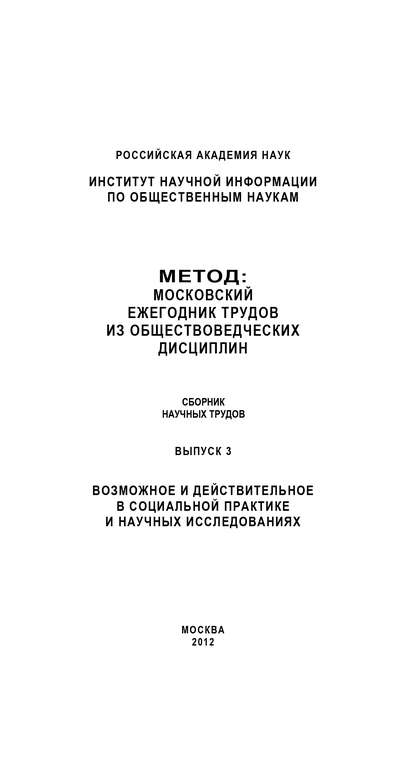По всем вопросам обращайтесь на: info@litportal.ru
(©) 2003-2024.
✖
Метод. Московский ежегодник трудов из обществоведческих дисциплин. Выпуск 3: Возможное и действительное в социальной практике и научных исследованиях
Автор
Год написания книги
2012
Настройки чтения
Размер шрифта
Высота строк
Поля
Ахременко А.С. Закономерности и связи в политической науке: Проблема «неоднородности» и ее количественное выражение // Общественные науки и современность. – М., 2010. – № 1. – С. 51–63.
Ахременко А.С. Оценка эффективности государства в производстве публичных услуг // ПОЛИС. – М., 2012. – № 1. – С. 113–135.
Гаман-Голутвина О.В. Меняющаяся роль государства в контексте реформ государственного управления: Отечественный и зарубежный опыт // ПОЛИС. – М., 2007. – № 4. – С. 24–45.
Гоголева Т.Н. Качественные и количественные подходы к анализу взаимодействия экономического роста и конкурентоспособности региона // ИнВестРегион. – Воронеж, 2007. – № 2. – С. 20–23.
Методика оценки эффективности деятельности органов исполнительной власти субъектов Российской Федерации (в ред. Постановления Правительства РФ от 01.04.2010 N 212). – Mode of access: http://www.minregion.ru/activities/monitor/exec_evaluation (Дата посещения: 18.11.11.) Регионы России. Социально-экономические показатели. – М., 2010. – Mode of access: http://gks.ru/wps/wcm/connect/rosstat/rosstatsite/main/publishing/catalog/statisticCollections/doc_1138623506156 (Дата посещения: 18.11.11.)
Самуэльсон П., Нордхаус В. Микроэкономика. – Москва; СПб.; Киев: Вильямс, 2008. – 752 с.
Adsera A., Boix C., Payne M. Are you being served? Political accountability and quality of government // The journal of law, economics and organization. – Oxford, 2003. – Vol. 19, N 2. – P. 445–490.
Andrews M. The good governance agenda: Beyond indicators without theory // Oxford development studies. – Oxford, 2008. – Vol. 36, N 4. – P. 379–407.
Andrews M. Good government means different things in different countries // Governance: An international journal of policy, administration, and institutions. – Oxford, 2010. – Vol. 23, N 1. – P. 7–35.
Afonso A., Aubyn M. Non-parametric approaches to education and health efficiency in OECD countries // Journal of applied economics. – Buenos Aires, 2005. – Vol. 8(2) – P. 227–246.
Afonso A., Aubyn M. Relative efficiency of health provision: A DEA approach with nondiscretionary inputs // Working papers / Department of economics, ISEG, Technical univ. of Lisbon. – 2006. – 2006/33–32 p. – Mode of access: http://ideas.repec.org/p/ise/isegwp/wp332006.html (Дата посещения: 18.11.11.)
Akhremenko A. Good governance: Efficiency as a variable and effectiveness as a structure: Working paper for the сonference «Lessons from subnational comparative politics: theory and method in the third decade of studying Russia’s regions». – Iowa, 2011. – 34 p. – Mode of access: http://ir.uiowa.edu/cgi/viewcontent.cgi?article=1114&context=shambaugh (Дата посещения: 18.11.11.)
Aubyn M. Law and order efficiency measurement – a literature review // Working paper / Technical univ. of Lisbon. – 2008. – N 19. – 28 p. – Mode of access: http://ssrn.com/abstract=1162120 (Дата посещения: 18.11.11.)
Carrigan C., Coglianese C. The politics of regulation: From new institutionalism to new governance / The annual review of political science. – Palo Alto, 2011. – Vol. 14. – P. 107–129.
Charnes A., Cooper W., Rhodes E. Measuring the efficiency of decision making units // European journal of operational research. – Amsterdam, 1978. – Vol. 2 (6). – P. 429–444.
Charron N. Government quality and vertical power-sharing in fractionalized states // The journal of federalism. – Oxford, 2009. – Vol. 39, N 4. – P. 585–605.
Coelli T. An introduction to efficiency and productivity analysis. – N.Y.: Springer, 2005. – 350 p. Delhey J., Newton K. Predicting cross-national levels of social trust: Global pattern or nordic exceptionalism? // European sociological review. – Oxford, 2005. – Vol. 21. – P. 311–327.
Easterly W., Woolcock R.M. Social cohesion, institutions, and growth: Working paper / Centre for global development. – Washington DC, 2006. – 94. – 34 p. – Mode of access: http://cdi.mecon.gov.ar/biblio/doc/cgdev/wp94.pdf (Дата посещения: 18.11.11.)
Easton D. The political system. – N.Y.: Knopf, 1953. – 330 p.
Fare R., Grosskopf Sh., Roos P. Malmquist productivity indexes: A survey of theory and practice // Index numbers: Essays in honor of Sten Malmquist / Grosskopf Sh., Russell R.R. (eds.). – N.Y.: Springer, 1997. – P. 127–185.
Farrell M. The Measurement of productive efficiency // Journal of the Royal statistical society. Series A (General). – L., 1957. – Vol. 120, N 3 – P. 253–290.
Giordano R., Tommasino P. Public sector efficiency and political culture // Working papers of Italian bank. – 2011. – N 786. – 34 p. – Mode of access: http://ssrn.com/abstract=1829965 (Дата посещения: 18.11.11.)
Grosse S., Teutsch S., Haddix A. Lessons from cost-effectiveness research for United States public health policy // Annual review of public health. – Palo Alto, 2007. – Vol. 28. – P. 365–391.
Huther J., Shah A. A simple measure of good governance // Public services delivery / Ed. Anwar Shah. – Washington, DC: The world bank, 2005. – P. 39–62.
Kaufmann D., Kraay A., Mastruzzi M. The worldwide governance indicators methodology and analytical issues: Draft policy research working paper. – 2010. – Mode of access: http://info.worldbank.org/governance/wgi/pdf/WGI.pdf (Дата посещения: 18.11.11.)
Kenis K., Provan K. Modes of network governance: Structure, management, and effectiveness // Journal of public administration research and theory. – Oxford, 2007. – Vol. 18. – P. 229–252.
Kus B. Regulatory governance and the informal economy: Cross-national comparisons // Socioeconomic review. – Oxford, 2010. – Vol. 8. – P. 487–510.
The quality of government / La Porta R., Lopez-de-Silanes F., Shleifer A., Vishny R. // Journal of law, economics and organization. – Oxford, 1999. – Vol. 15 (1). – P. 222–279.
Levitsky S., Murillo M.V. Variation in institutional strength // Annual review of political science. – Palo Alto, 2009. – Vol. 12. – P. 115–133.
Meltzer D. Accounting for future costs in medical cost-effectiveness analysis // Journal of health economics. – Amsterdam, 1997. – Vol. 16. – P. 33–64.
Neumann P. Using cost-effectiveness analysis to improve health care. – N.Y.: Oxford univ. press, 2005. – 209 p.
Persson T., Tabellini G. Political economics. – Cambridge, MA: MIT press, 2000. – 533 p.
Putnam R. Making democracy work: Civic traditions in modern italy. – Princeton, N.J.: Princeton univ. press, 1993. – 280 p.
Rostein B., Teorell J. What is quality of government? A theory of impartial government institutions // Governance: An international journal of policy, administration, and institutions. – Oxford, 2008. – Vol. 21, N 2 (April). – P. 165–190.
Rogowski R. Trade and the variety of democratic institutions // International organization. – Cambridge, MA: MIT press, 1987. – Vol. 41. – P. 203–223.
Thomas M.A. What do the worldwide governance indicators measure? // European journal of development research. – Brunel Road: Macmillan, 2009. – Vol. 22. – P. 31–54.
Translating national policy objectives into local achievements across planes of governance and among multiple actors: Second-order devolution and welfare reform implementation / Cho Ch., Kelleher A., Wright D., Yackee S. // Journal of public administration research and theory. – Oxford, 2005. – Vol. 15, N 1. – P. 31–54.
Trust in transition: Cross-country and firm evidence / Raiser M., Rousso A., Steves F., Teksoz U. // The journal of law, economics, & organization. – Oxford, 2007. – Vol. 24, N 2. – P. 407–433.
Unlocking the human potential for public sector performance: United Nations world public sector report, N.Y., 2005. – Mode of access: http://unpan1.un.org/intradoc/groups/public/documents/ un/unpan021616.pdf (Дата посещения: 18.11.11.)
Wolfowitz P.A. Regime changes. – L.: The economist, 2005. – Mode of access: http://www.economist.com/node/4032601 (Дата посещения: 18.11.11.)
Приложение
Таблица 1
Результаты множественного регрессионного анализа влияния институциональных реформ на эффективность региональных систем здравоохранения
* Бета-коэффициенты значимы на уровне ?0,05
** Бета-коэффициенты значимы на уровне ?0,01
Таблица 2
Корреляции между технической и социальной эффективностью
* коэффициент значим на уровне <0,05;
** коэффициент значим на уровне <0,01
Таблица 3

















